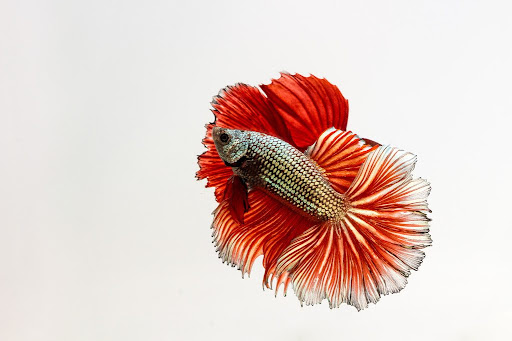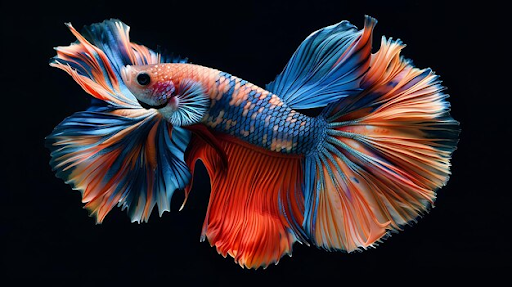Betta fish, often celebrated for their stunning colors and graceful fins, hold a special place in the hearts of many aquarium enthusiasts. These captivating creatures are not just visually appealing; they also boast distinct personalities and are relatively easy to care for, contributing to their increasing global popularity. Dive deep into the enchanting world of beautiful Bettas, exploring their history, aesthetic characteristics, and how to care for them properly.
Table of Contents
The Fascinating History and Origin of Betta Fish
Origins in Southeast Asia
Betta fish, originally from Southeast Asia’s warm, shallow waters, have a rich history that intertwines beauty and utility. Initially admired for their vibrant colors, these fish were later bred for combat, a practice that dates back centuries. The Siamese fighting fish, as they are commonly known, gained a reputation for their aesthetics and spirited nature. Over time, Betta fish transitioned from fighting fish to cherished pets adored by aquarists worldwide.
Global Introduction
The journey of Betta fish beyond Southeast Asia marks a significant chapter in their history. Their introduction to various countries has allowed them to flourish as popular aquarium pets. These remarkable fish, with their flowing fins and dazzling colors, have become beloved companions for many. Today, they are seen as symbols of grace and elegance in the aquatic world.
Evolution of Aesthetic Appeal
The aesthetics of Betta fish have evolved remarkably over the years. Through selective breeding, enthusiasts have enhanced their vibrant colors and unique fin shapes. This has led to a diverse range of visually stunning varieties that continue to captivate fish keepers everywhere. The artistry behind these fish has transformed them into living works of art that can enhance any aquarium setting.
Aesthetic Characteristics of Betta Fish
Vibrant and Colorful Scales
One of the most striking features of Betta fish is their vivid scales, which display a beautiful array of colors. These hues, from deep blues to fiery reds and shimmering greens, create a breathtaking visual display. Beyond their aesthetic value, the colors also serve crucial roles in communication and camouflage, aiding their survival in the wild.
Unique Patterns
The patterns found on Betta fish are as diverse as the colors they display. Each fish showcases its unique design, offering endless possibilities for artistic interpretation. The intricate patterns can inspire creativity and innovation across various creative disciplines, allowing enthusiasts to appreciate the beauty of these fish in multiple ways.
The Elegance of Flowing Fins
Betta fish are renowned for their long, flowing fins, which add to their allure. The delicate movement of these fins as the fish swims creates a mesmerizing display of grace. This elegance enhances the overall charm of these aquatic creatures, making them a favorite among aquarium enthusiasts.
Variations in Size and Shape
Betta fish come in various sizes and shapes, contributing to their diversity. These variations can influence their characteristics and interactions, leading to a rich tapestry of life in the aquarium. Understanding these differences can help aquarists appreciate the unique traits that each Betta brings to the table.
Classification of Betta Fish: Exploring Diverse Breeds
Siamese Fighting Fish
The Siamese fighting fish is perhaps the most well-known Betta variety. Its vibrant colors and flowing fins make it a favorite among aquarists. These spirited fish display a range of aggressive behaviors, particularly during mating rituals, which adds to their intrigue. They thrive in warm waters and require specific care to maintain their health and beauty.
Crown-Tail Betta Fish
Crown-tail Betta fish are distinguished by their striking fins, divided into pointed spikes resembling a crown. This unique feature makes them a popular choice among fish enthusiasts. Their vibrant colors and patterns add to their appeal, making them a stunning addition to any aquarium.
Half-Moon Betta Fish
The Half-Moon Betta fish is known for its distinctive tail shape, which forms a perfect semicircle when fully spread. This captivating shape and various colors and patterns make the Half-Moon a beloved species among aquarium lovers.
Plakat Betta Fish
Plakat Betta fish are recognized for their vibrant colors and robust fins. These fish are often characterized by their aggressive nature, making them fascinating but sometimes challenging pets. Their shorter fins differentiate them from other varieties, adding to their unique charm.
Other Varieties
The world of Betta fish extends beyond the popular breeds mentioned above. There are numerous other varieties, each with its distinct characteristics and appeal. Engaging with these diverse breeds fosters a broader understanding of Betta fish and enhances the fishkeeping experience.
The Palette of Betta Fish: Understanding Colors and Patterns
Genetic Determinants of Color
Genetic factors influence the stunning colors of Betta fish. Specific genes dictate pigmentation, leading to the beautiful hues that make these fish so captivating. Understanding the genetics behind their colors can provide insights into their evolution and adaptability.
Common and Rare Colors
Betta fish come in an impressive range of colors, with common shades including blue, red, and purple. However, some variations, such as butterfly patterns or metallic hues, are considered rare and highly sought after. Collectors often prize these unique specimens for their striking appearances.
Fascinating Patterns
The patterns on Betta fish add another layer of intrigue to their aesthetics. From marbled designs to intricate spots, each pattern tells a story and contributes to the overall beauty of the fish. Discussing these patterns encourages a deeper appreciation for the diversity found within this species.
Environmental Influence on Color
The environment plays a significant role in how colors are perceived in Betta fish. Factors such as diet, water quality, and lighting can alter pigmentation, enhancing or dulling their natural beauty. Creating an optimal environment is essential for showcasing the vibrant colors of these aquatic companions.
Environmental Influence on Aesthetic Splendor
Impact of Environment on Health and Beauty
The health and beauty of Betta fish are closely linked to their environment. Water quality, temperature, and habitat significantly influence their coloration and overall vitality. Maintaining optimal conditions ensures that Betta fish thrive and retain their aesthetic appeal.
Ideal Living Conditions
To preserve the aesthetics of Betta fish, it is important to create a harmonious living environment. This involves balancing color schemes, ensuring adequate light exposure, and incorporating natural elements into the aquarium. Thoughtful decoration enhances visual appeal and promotes a tranquil atmosphere for fish and keepers.
Caring for Your Betta Fish: Maintaining Their Aesthetic Appeal
Ideal Diet for Betta Fish
A nutritious diet is essential for maintaining the health and beauty of Betta fish. A varied diet should include high-quality pellets and occasional freeze-dried or frozen foods, such as bloodworms and brine shrimp. Providing live foods can further enhance their nutrition and stimulate natural behaviors.
Best Practices for Tank Maintenance
Regular maintenance is key to keeping a Betta fish tank healthy. This includes cleaning the substrate, performing partial water changes weekly, monitoring temperature and pH levels, and using a suitable filter. Avoiding overcrowding and feeding appropriately is also essential for optimal care.
Importance of Mental Stimulation and Exercise
Betta fish thrive on mental stimulation and physical exercise. Engaging them in activities and providing enrichment can enhance their overall well-being. A healthy mind and body contribute to a happier, more vibrant Betta fish.
Boosting Aesthetic Appeal: Breeding and Crossbreeding Betta Fish
Selecting Ideal Breeding Pairs
Choosing the right Betta fish pair for breeding is crucial for ensuring healthy offspring. Selecting compatible traits, colors, and temperaments increases the chances of successful reproduction and enhances the aesthetic qualities of the resulting fry.
Crossbreeding for Color and Pattern Variation
Crossbreeding involves mating selected individuals to create offspring with desired traits. By combining genetic material from different breeds, breeders can achieve diverse phenotypes that enhance aesthetic appeal. This practice can also potentially improve the health of the new generations.
The Influence of Aesthetic Splendor on Betta Fish Price
How Aesthetics Affect Pricing
The aesthetic qualities of Betta fish play a significant role in determining their price. Fish with vibrant colors, unique fin structures, and rare patterns often command higher prices among enthusiasts. Collectors are willing to pay a premium for visually stunning specimens.
Comparing Prices of Common and Rare Varieties
Regarding price differences, standard colors, and patterns typically sell for less due to their abundance. In contrast, rare colors and unique patterns often fetch higher prices, driven by demand among collectors. This market dynamic highlights the importance of aesthetics in the Betta fish industry.
Beautiful Betta FAQs
What is the prettiest Betta fish?
The most beautiful Betta fish can vary according to personal preference. Still, many enthusiasts consider varieties like the Half-Moon, Crowntail, and Butterfly particularly stunning due to their vibrant colors and flowing fins.
What is the fanciest Betta?
The fanciest Betta fish is often considered the Crowntail, known for its elaborate fin structures that resemble crowns. Other varieties, such as Halfmoons and Veiltails, also captivate with their unique colors and patterns.
What type of Betta is most aggressive?
Siamese fighting fish are known for their aggressive nature, especially during territorial disputes. This competitive behavior is characteristic of the species, making them one of the more challenging Betta varieties to keep.
What is the rarest Betta fish?
The Cambodian Betta is often regarded as one of the rarest varieties, distinguished by its unique coloration and pattern. Its striking appearance makes it highly sought after among collectors and enthusiasts alike.
In conclusion, Betta fish are stunning in appearance, possess fascinating behaviors, and have rich histories. By understanding their needs and characteristics, aquarists can create an environment that enhances their beauty while ensuring their health and happiness. Whether you are a seasoned enthusiast or just starting your journey with Betta fish, their aesthetic splendor will surely inspire and captivate.

